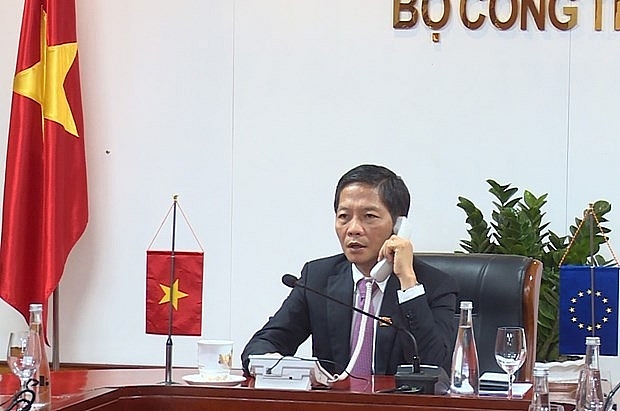EVFTA hoped to take effect on August 1
 |
| Minister of Industry and Trade Tran Tuan Anh talks over the phone with EU Trade Commissioner Phil Hogan on June 8 (Photo: VNA) |
The talks took place right after the Vietnamese National Assembly (NA) had ratified the deal earlier the same day.
According to the EU’s internal procedures, the EVFTA needs the European Parliament’s ratification and then the European Council’s approval to come into force.
On February 12 this year, the European Parliament ratified the agreement with 63,35 percent of votes in favour. The European Council also approved the trade pact on March 30 and sent a document to Vietnam on April 24 to inform about the EU’s completion of its last legal procedure.
Meanwhile, the EVFTA sailed through the Vietnamese NA on June 8 with the support of all lawmakers present at the plenum.
Under Article 17.16 of this deal, the EVFTA will take effect on the first day of the second month after the month when both sides inform each other about the completion of corresponding legal procedures for the enforcement, or another date agreed on by both sides.
According to Vietnam’s 2016 law on international treaties, after the NA issued a resolution ratifying the EVFTA (usually one week), the Ministry of Foreign Affairs will announce the country’s completion of domestic legal procedures to the EU.
As the EU already gave the notification to Vietnam in April, Vietnam’s coming announcement will also set the date for the EVFTA to take effect for both sides, August 1 as expected.
In case the country wishes the agreement to become effective on an earlier date, it will have to discuss with the EU and wait for results of the bloc’s internal consultation. If the internal consultation lasts for more than three weeks, it will be hard for the Foreign Ministry of Vietnam to send the announcement of the country’s completion of internal procedures to the EU before July 1, according to the officials.
What the stars mean:
★ Poor ★ ★ Promising ★★★ Good ★★★★ Very good ★★★★★ Exceptional
 Tag:
Tag:
Related Contents
Latest News
More News
- Businesses ramp up production as year-end orders surge (December 30, 2025 | 10:05)
- Vietjet chairwoman awarded Labour Hero title (December 29, 2025 | 13:06)
- How to unlock ESG value through green innovation (December 29, 2025 | 10:03)
- AI reshapes media and advertising industry (December 29, 2025 | 08:33)
- FPT and GELEX sign deal to develop blockchain tech for global markets (December 29, 2025 | 08:29)
- Vietnam’s GDP forecast to grow by 9 per cent in 2026 (December 29, 2025 | 08:29)
- Women entrepreneurs are key to Vietnam’s economic growth (December 29, 2025 | 08:00)
- Vietnam's top 500 value-creating enterprises announced (December 27, 2025 | 08:00)
- The PAN Group shaping a better future with ESG strategy (December 26, 2025 | 09:00)
- Masan Consumer officially lists on HSX, marking the next phase of value creation (December 25, 2025 | 13:20)























 Mobile Version
Mobile Version